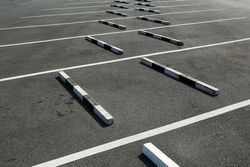
Sealcoating involves applying a protective coating to an asphalt-based pavement to preserve its integrity. Without this vital layer, elements like water, oil, and sunlight may penetrate the asphalt and cause cracking, fading, and other undesirable effects. Ultimately, this finishing step helps improve the aesthetic appeal, function, and lifespan of any asphalt surface.
The Sealcoating Process: What You Need to Know
Initial Coating
Sealcoating mixtures are made from an ultra-thin layer of asphalt and materials like polymer additives, silica sand, or other fillers. A professional may apply this coating with a brush, squeegee, or another device. To ensure a smooth application, however, the surface should be completely dry, and the temperature should not be lower than 50 degrees Fahrenheit. After the application, it needs at least 24 hours to dry. Typically, you should not sealcoat new pavement for at least 90 days after the installation, as the surface needs ample time to cure.
Maintenance
 Sealcoating helps cut down on the amount of maintenance required. However, you will need to sealcoat the surface every three to five years to maintain optimal results. Inclement weather, vehicle traffic, and chemical spills may impact the frequency at which you need to sealcoat.
Sealcoating helps cut down on the amount of maintenance required. However, you will need to sealcoat the surface every three to five years to maintain optimal results. Inclement weather, vehicle traffic, and chemical spills may impact the frequency at which you need to sealcoat.
Safety
In addition to protecting against the elements, the special mixture also reduces slippage for cars and pedestrians by increasing the asphalt’s friction. Without regular sealcoating, any type of traffic may cause the asphalt to become smooth and therefore slippery, which can raise safety concerns.
If you want your asphalt driveway or lot to last, invest in regular sealcoating. Since 2000, the premier team from Billy S. Young’s Blacktop Paving has been providing the high-quality residential and commercial sealcoating services Waynesboro, VA, locals rely on. To learn about how the team will support your next project, visit the website. You may also call a friendly professional today at (540) 949-0432.
About the Business
(5 reviews)
Have a question? Ask the experts!
Send your question

